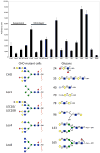The bisecting GlcNAc in cell growth control and tumor progression
- PMID: 22476631
- PMCID: PMC3459286
- DOI: 10.1007/s10719-012-9373-6
The bisecting GlcNAc in cell growth control and tumor progression
Abstract
The bisecting GlcNAc is transferred to the core mannose residue of complex or hybrid N-glycans on glycoproteins by the β1,4-N-acetylglucosaminyltransferase III (GlcNAcT-III) or MGAT3. The addition of the bisecting GlcNAc confers unique lectin recognition properties to N-glycans. Thus, LEC10 gain-of-function Chinese hamster ovary (CHO) cells selected for the acquisition of ricin resistance, carry N-glycans with a bisecting GlcNAc, which enhances the binding of the erythroagglutinin E-PHA, but reduces the binding of ricin and galectins-1, -3 and -8. The altered interaction with galactose-binding lectins suggests that the bisecting GlcNAc affects N-glycan conformation. LEC10 mutants expressing polyoma middle T antigen (PyMT) exhibit reduced growth factor signaling. Furthermore, PyMT-induced mammary tumors lacking MGAT3, progress more rapidly than tumors with the bisecting GlcNAc on N-glycans of cell surface glycoproteins. In recent years, evidence for a new paradigm of cell growth control has emerged involving regulation of cell surface residency of growth factor and cytokine receptors via interactions and cross-linking of their branched N-glycans with a lattice of galectin(s). Specific cross-linking of glycoprotein receptors in the lattice regulates their endocytosis, leading to effects on growth factor-induced signaling. This review will describe evidence that the bisecting GlcNAc of N-glycans regulates cellular signaling and tumor progression, apparently through modulating N-glycan/galectin interactions.
Figures



References
-
- Gerken TA, Jamison O, Perrine CL, Collette JC, Moinova H, Ravi L, Markowitz SD, Shen W, Patel H, Tabak LA. Emerging paradigms for the initiation of mucin-type protein O-glycosylation by the polypeptide GalNAc transferase family of glycosyltransferases. J Biol Chem. 2011;286(16):14493–14507. doi: 10.1074/jbc.M111.218701. - DOI - PMC - PubMed
Publication types
MeSH terms
Substances
Grants and funding
LinkOut - more resources
Full Text Sources

